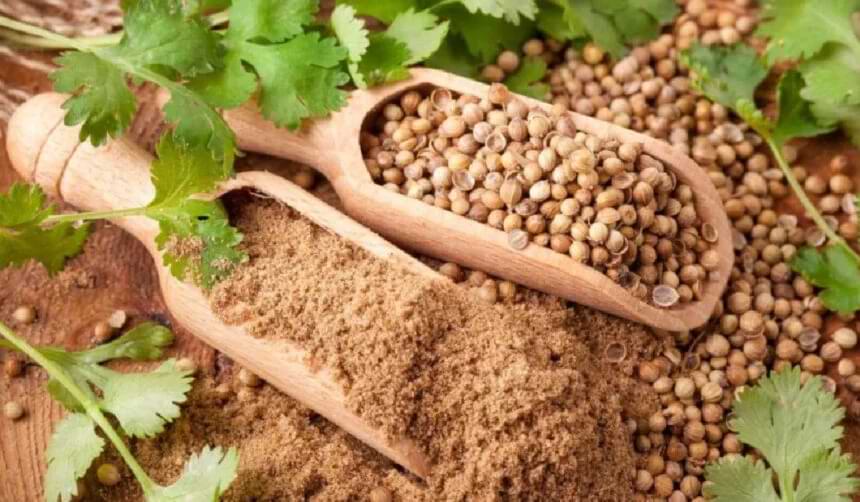Introduction
Koriandri, also known as Coriandrum sativum, is a widely recognized plant used in cooking, medicine, and culture worldwide. In different places, it is known as Coriander or cilantro. The fresh green leaves (cilantro) are loved for their lemon-like taste, while the dried seed (Coriander) is used for its warm, nutty flavor in spice mixes.
It belongs to the Apiaceae family and is also called dhania in India, kuzbara in the Middle East, and Koriandri in Albania. This herb connects farms, kitchens, and traditional healing methods across many countries.
Botanical Description of Koriandri
Koriandri is a small, soft green plant with thin, parsley-like leaves, tiny white or light pink flowers, and round seeds that turn golden brown when ripe. It grows for one season, reaching around 50–60 cm tall. The seeds sprout within two weeks, and the plant grows quickly before flowering and producing seeds. It grows best in sunny weather and well-drained soil. While it looks like parsley, its smell and seed shape make it easy to identify.
There’s plenty more to explore—check out our other posts!
The Origins and Global Spread of Koriandri
Koriandri has been used for more than 7,000 years. Its earliest use was in the Mediterranean and Southwest Asia. Seeds have even been found in the tomb of King Tutankhamun in Egypt, demonstrating their value in food and rituals. The Greeks and Romans used it to flavor bread, wine, and medicines.
As trade expanded, Koriandri spread to India, China, Europe, and the Americas. It became a key component of Indian spice blends, European baking, and Latin American salsas, demonstrating its widespread use in global cooking.
Culinary Uses of Koriandri Around the World
Koriandri Leaves (Cilantro)
The fresh green leaves are known for their citrus-like taste. They are used in Latin American, Indian, Thai, and Vietnamese foods. Fresh leaves add flavor to guacamole, curries, soups, and chutneys. They are usually added at the end of cooking to keep their taste.
Koriandri Seeds (Coriander)
The seeds are roasted and ground to create spice mixes, including curry powder, garam masala, and pickling blends. When toasted, their flavor becomes stronger and more prosperous. In Europe, they are added to bread, sausages, and drinks.
Popular Dishes
-
India: chutneys, biryani, and sambar
-
Mexico: salsa, guacamole, tacos
-
Middle East: tabbouleh, falafel
-
Albania: dishes like Tava e Dhiut and Fërgesë
Nutritional Value of Koriandri
Koriandri is full of nutrients. It has vitamins C, K, and A, plus minerals like iron, potassium, and magnesium. These help the immune system, bones, skin, and muscles. It also contains fiber, antioxidants, and natural oils that improve digestion and reduce inflammation. Since it is low in calories, it’s an excellent choice for healthy diets.
Health Benefits of Koriandri
-
Helps digestion and reduces bloating
-
Contains antioxidants that fight stress in the body
-
Reduces inflammation and supports joint health
-
May lower blood sugar and cholesterol
-
Protects the heart, bones, and immune system
-
Improves skin health and fights infections
Genetic Factors and Taste Perception
Not everyone enjoys Koriandri. Some people love its fresh, lemony flavor, but others think it tastes like soap. This is because of a genetic difference in the OR6A2 gene, which makes some people more sensitive to natural compounds in the leaves.
How to Grow Coriander at Home
Koriandri is easy to grow in soil or pots. It needs 4–6 hours of sunlight and soft, well-drained soil. Sow the seeds 1 cm deep after the frost season. Keep the soil moist but not too wet. Pick the leaves early before the plant produces seeds, or let it flower if you want to collect the seeds. Adding compost and using natural pest control helps it grow better.
Best Ways to Store Coriander
-
Leaves: Wrap in damp paper towels and keep in a bag in the fridge. Or freeze chopped leaves in ice cube trays with water or oil.
-
Seeds: Dry them thoroughly and store in airtight jars away from heat and moisture. Vacuum sealing is ideal for long-term storage.
Koriandri in Traditional Medicine
In Ayurveda, Corianderm is used as a cooling herb that aids digestion, reduces fever, and purifies the body. In Chinese medicine, it is associated with energy and longevity. In Unani and folk remedies, it aids in kidney health and alleviates menstrual issues. It is often used as tea, infusion, or decoction.
Non-Culinary Uses of Koriandri
-
Skincare: Oil is used to treat acne and reduce inflammation
-
Aromatherapy: Helps reduce stress and calm the mind
-
Oral care: Chewing leaves fights bad breath
-
Gardening: Its strong smell keeps pests away
Koriandri and Sustainable Agriculture
Koriandri improves soil quality when used in crop rotation and attracts bees with its flowers. It also works well with other plants like legumes and greens, helping farms reduce pests and improve harvests. Because it grows in small spaces, it’s perfect for urban gardening.
Scientific Research and Modern Applications
Studies show that Koriandri has antioxidant, anti-diabetic, and cholesterol-lowering effects. Its extracts and oils are now used in medicines, cosmetics, and health supplements. Ongoing research is testing its use for brain health and inflammation.
Common Myths and Misunderstandings
-
Myth 1: Cand and Coriander are different plants → False. They are parts of the same plant.
-
Myth 2: It has no nutrition → False. It is full of vitamins, minerals, and antioxidants.
-
Myth 3: It always tastes soapy → False. Only some people have the gene that causes this.
-
Myth 4: It causes many allergies → False. Allergic reactions are rare.
Side Effects and Precautions
Koriandri is safe for most people. But:
-
Those allergic to the Apiaceae family should avoid it.
-
Overeating may cause stomach upset.
-
Pregnant or breastfeeding women should only eat it in normal food amounts.
-
People on blood-thinning medicine should talk to their doctor before using it regularly.
Koriandri in Culture and Folklore
Koriandri is linked with health, warmth, and protection in many cultures. It has been used in weddings, festivals, and rituals. Folklore suggests that it can bring good luck and ward off evil. In Albania and the Mediterranean, it is still celebrated as a key kitchen and garden herb.
Easy Recipes Featuring Koriandri
-
Fresh Koriandri Chutney: Blend leaves with mint, garlic, lemon, and chili
-
Spiced Koriandri Rice: Add crushed seeds to basmati rice and vegetables
-
Coriander Chicken Curry: Use both seeds and leaves in yogurt-marinated chicken
-
Herbal Tea: Boil seeds with fennel and ginger
-
Koriandri Salad Dressing: Mix leaves with lime, olive oil, honey, and cumin
Koriandri in Urban Kitchens
Modern chefs love Coriander for its bold taste and health benefits. It fits well with vegetarian, vegan, and keto diets. Since it grows easily in containers, it is perfect for city kitchens and small gardens.
Alternative Names in Different Regions
| Region | Name |
| India | Dhania |
| USA |
Cileaves) Coriander (seeds)
|
| Europe | Coriander |
| Middle East | Kuzbara |
| Latin America | Cilantro |
| Albania | Koriandri |
Want to learn more? Our full collection of posts is ready for you!
Final Thoughts
Koriandri is more than just a cooking herb. It brings together food, health, and tradition. Easy to grow and rich in benefits, it belongs in every kitchen. Whether used in spices, teas, or fresh dishes, it continues to improve health and add flavor worldwide.
FAQs
What is Koriandri?
Koriandri is the same Coriander (Coriandrum sativum). The leaves are called cilantro, and the seeds are called Coriander.
What are the health benefits of Koriandri?
It helps with digestion, lowers sugar and cholesterol, reduces inflammation, and provides vitamins and minerals.
How can I use Coriander in food?
Use fresh leaves in salads, soups, and chutneys, and use the seeds in curries, spice mixes, and breads.
Why does Koriandri taste like soap to some people?
Some people have a gene (OR6A2) that makes the leaves taste soapy due to natural compounds in the plant.
Can I grow Koriandri at home easily?
Yes, it grows well in pots or gardens with sunlight and water. Leaves can be picked in 3–4 weeks, and seeds in 6–8 weeks.




